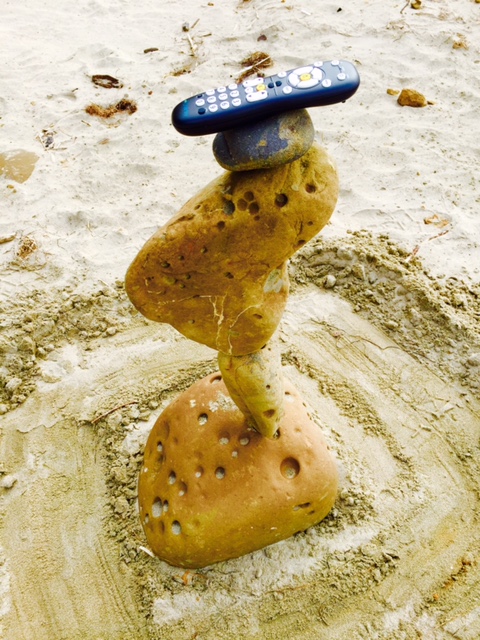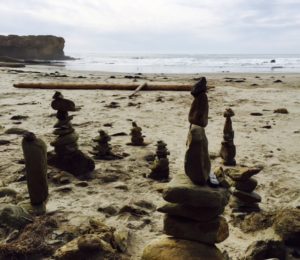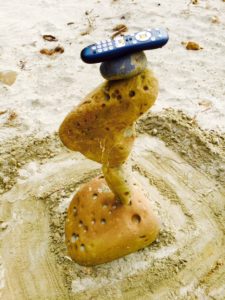Remote Control Displacement: I placed a remote control device on a Pacific Ocean beach during Hurricane Patricia. (Far north of the actual hurricane.)
Otter Rock, Oregon USA
Vicki Krohn Amorose
1. (social response) I was unable to assess the social response because, as explained in #2, forces out of my control displaced the displaced object. I’m fairly certain that someone took the remote control because I searched all around the toppled rocks. Maybe they were preventing litter, or maybe a child took it as a toy. If the remote control was swallowed by a wave, it’s likely to emerge on the beach again, and there’s a possibility of further interaction.
2. (efforts) I began with the thought that the entire Oregon state coastline is legally public space. The beach cannot be private property, as declared by the Oregon Beach Bill of 1967. In Otter Rock, Oregon, I discovered a cluster of balancing stone sculptures placed next to the beach cliff. Someone else created these vernacular mini-monuments; this was the other person or persons involved in the project. I chose this surprising spot to place a TV remote control.
The remote control is a ubiquitous object suggesting a certain power and sense of control. We need to know where our remote control is located and we get anxious if it’s lost. It’s jarring to see one out in nature. The farther away from inhabited space I carried the remote control, the more displaced it became. I was playing with ideas that might be provoked through this displacement: perceptions of control, and the cultural habit of constantly shifting our attention back-and-forth between the 2-dimensional and the 3-dimensional –between screens and the real world.
I spent 3 hours watching people from a distance. I saw a total of 9 people; none spotted the object or the balancing stones. I left it overnight and planned to return the next day, a Saturday, when more people would be out walking and I could initiate conversation. I sheltered the object from wind, and I thought it rested far enough back from the high tide line so that it wouldn’t become plastic flotsam. (Yes I removed the batteries.) 24-hours later I returned to find all the balancing stones toppled and the remote control was nowhere to be found. The balancing stones were not constructed above the tide line, as I had assumed. Wind and waves did their thing. This result was unexpected and turned the farcical notion of “control” back on me. (Note: I left the beach at 3:40 pm and high tide was 11:20 pm.)
3. (references) Clearly this is public art outside of an urban setting, such as in the land art of Nancy Holt. I was intervening as an individual in public space as in the work of Sophie Calle. This was also ephemeral public art, speaking to a particular moment in time. The remote control faced the Pacific Ocean precisely during the hours that Hurricane Patricia made landfall on 10/23/15. The hurricane hit 2600 miles South of the location. The story dominated the news, so I believe that most people walking the beach would have at least a passing thought about its impact. Hurricane Patricia was “remote.” Here on this beach, the public feels in “control” of our lives and property.




